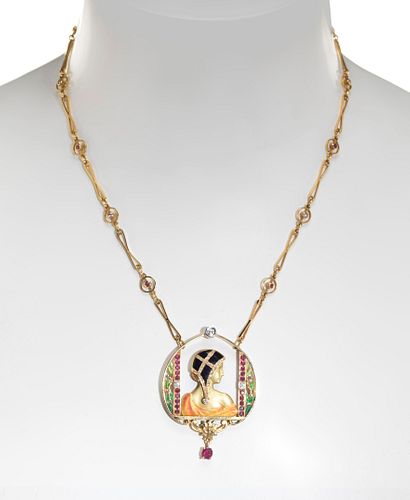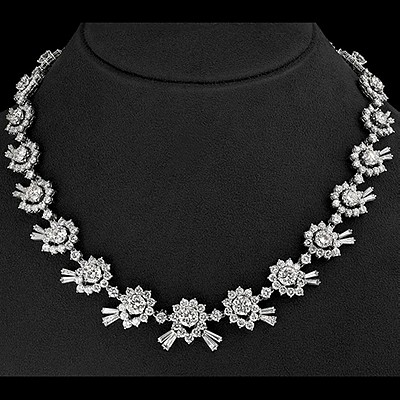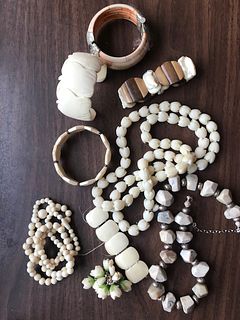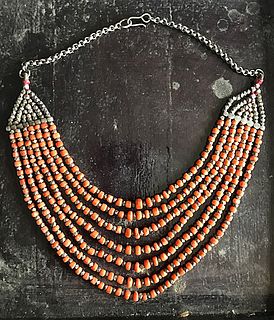Choker Art Nouveau style Masriera and Brothers in 18kt yellow gold.
Lot 57
About Seller
Setdart Auction House
Carrer Aragó 346
Barcelona
Spain
Setdart Subastas was born in 2004 and is currently the first online art auction in Spain with solidity, prestige and reliability guaranteed by our more than 60,000 users. Setdart has a young, dynamic and enterprising team ready to successfully manage the purchase and sale of art works through custom...Read more
Categories
Estimate:
EUR€6,000 - EUR€7,000
$6,250 - $7,291.67
Absentee vs Live bid
Two ways to bid:
- Leave a max absentee bid and the platform will bid on your behalf up to your maximum bid during the live auction.
- Bid live during the auction and your bids will be submitted real-time to the auctioneer.
Bid Increments
| Price | Bid Increment |
|---|---|
| EUR€0 | EUR€10 |
| EUR€200 | EUR€25 |
| EUR€500 | EUR€50 |
| EUR€1,000 | EUR€100 |
| EUR€3,000 | EUR€200 |
| EUR€5,000 | EUR€500 |
| EUR€10,000 | EUR€1,000 |
| EUR€20,000 | EUR€2,000 |
| EUR€50,000 | EUR€5,000 |
About Auction
By Setdart Auction House
Jun 28, 2021
Set Reminder
2021-06-28 07:00:00
2021-06-28 07:00:00
America/New_York
Bidsquare
Bidsquare : Numismatics, Jewelry and Watches
https://www.bidsquare.com/auctions/setdart-auction-house/numismatics-jewelry-and-watches-7133
Setdart Auction House sofia@setdart.com
Setdart Auction House sofia@setdart.com
- Lot Description
Choker Art Nouveau style Masriera and Brothers in 18kt yellow gold. Art Nouveau frontispiece with marked classical symbolism, decorated with the figure of a lady in profile wearing a draped dress in translucent orange colors, wearing a hood decorated with dark blue enamel. The figure is framed in a fine and delicate structure of tumid format, flanked with columns of rubies with diamonds and delicate green enameled leaves. The piece is crowned by a brilliant-cut diamond, ca. 0.16 cts, mounted in chaton. Its lower part is decorated with palmettes from which hangs ruby, oval cut, set at the end, with movement, ca. 0.15 cts. Chain with link in the form of elongated "8" and rings-fly with a ruby alternating with brilliant, drawer clasp and insurance. Total weight of the diamond 0.30 cts. Measures: 5.5 x 3.7 cm (pendant); 26.5 cm (total length). The piece is inspired by the Masriera style. The firm was founded in Barcelona in 1838 by Josep Masriera Vidal. The process of making the pieces, from design to the final polishing, was carried out in the family workshop, which was expanded as demand increased and, with it, production. At the end of the 19th century, the Masriera workshop was already the most important in the city of Barcelona, obtaining the Gold Medal and the Unique Prize awarded by the Associació d'Artífexs en Joieria i Plateria de Barcelona (Association of Jewelers and Silversmiths of Barcelona). In 1887 they changed their name to "Masriera Hermanos", with Josep Masriera Manovens at the head, the production was extended to jewelry, partly thanks to the recovery of various techniques of enamel processing, together with his son Lluís Masriera Rosés, who became the jeweler of Catalan Modernism, achieving international renown. Within the art of the 19th century, modernism stood out as a synonym of the will to be modern; a concept, therefore, close to the new, modern art. This will was a vital attitude that, in territories like Catalonia, meant the union of the autochthonous tradition, of medieval origins, and the European modernity. As Luis Masriera has already stated "The modernist jewel clearly expresses the tendency of our time that leads to the absolute empire of the intellect. It sets its value mainly in the beauty and mastery of its sculpture, in the harmony and ideal combination of its enamels and in the whole artistic ensemble of its whole. Today the world of jewelry is a tiny world of things for artists, and it industrializes a flourishing branch of decorative art".
- Shipping Info
-
In-house shipping available. Please inquire at admin@setdart.com.
-
- Buyer's Premium



 EUR
EUR CAD
CAD AUD
AUD GBP
GBP MXN
MXN HKD
HKD CNY
CNY MYR
MYR SEK
SEK SGD
SGD CHF
CHF THB
THB

















